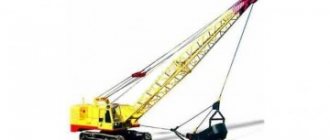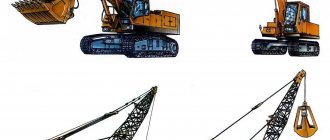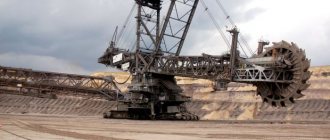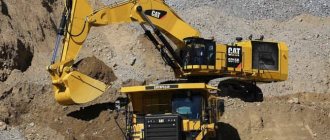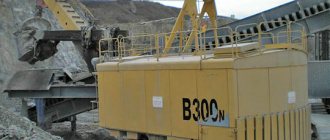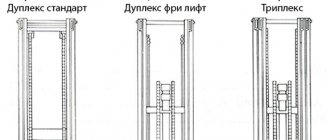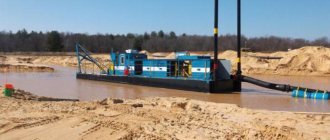A quarry excavator belongs to the category of large special equipment designed to work with large volumes of materials (soil, crushed stone, etc.). In the form in which this technology is known today, it appeared in 1936, when the American mining industry was actively developing and needed large, high-performance machines that could move around the quarry. Many types of minerals are currently mined by open-pit mining. This determines the demand and active use of mining excavators.
Areas of application
Such machines are used in the following types of open areas:
- mining and quarrying - in coal mining, development of ore and non-metallic deposits, in non-ferrous and ferrous metallurgy;
- construction and road construction - when preparing a site for the construction of large buildings, laying highways and highways.
The main types of work performed using a mining excavator:
- digging and extraction of materials (coal, ore, soil, etc.);
- site clearing;
- moving materials along a horizontal plane;
- loading materials onto transport for subsequent transportation.
The use of quarry excavators is appropriate wherever large amounts of work need to be performed. Otherwise, machines from the categories of medium or small-sized equipment are used.
Excavators on a construction site
This type of construction equipment digs and moves soil using a bucket or a continuous mechanism (chain or rotary).
Based on this requirement, excavators are divided into:
- for single-bucket periodic excavators;
- for continuous excavators.
The main parts of KAMAZ tractor construction excavators are the chassis (wheeled or tracked), a rotary platform with a power unit and replaceable working equipment.
Principle of operation
Quarry excavators are tracked, which ensures their ability to move freely over terrain with different terrain, including hilly and rough areas, ledges of quarries, etc. The main working element of such equipment is the bucket. Its design may vary depending on the type of task being performed. The machine's operating cycle consists of two basic stages:
- direct digging;
- moving material to the dump site or to the loading point.
Depending on the type of work performed, a crawler mining excavator can be equipped with a variety of attachments.
RH 400
The RH 400 is the largest hydraulic excavator in the world, built by the German company O&K. The weight of the mechanism is about 100 tons, and its power is 3.3 megawatts. The bucket of this model holds about 50 cubic meters. The RH 400 is ready for work even in very adverse weather conditions thanks to its advanced oil heating system. The engine power is 4,500 horsepower, and the fuel tank of the unit is designed for 15 thousand liters of fuel. The cost of one of these copies will cost the buyer 14 million dollars.
Design Features
The design of a mining excavator includes the following basic elements:
- body,
- arrow,
- turntable,
- bottom frame,
- two-legged stand,
- ladle,
- track frames,
- handle.
High-strength steel is used for the manufacture of structural elements, which makes them resistant to loads. This technique is capable of performing large-scale work at a wide range of external temperatures.
The reliability and endurance of mining excavators are also determined by design solutions, including:
- specialized mechanisms for braking the bottom of the bucket, which reduce vibrations of the bottom and prevent it from hitting the handle or body;
- the use of a leveling block in the bucket suspension, which reduces the load on the boom during work;
- half-blocks mounted on the handle beam, which increases the latter’s endurance and resistance to loads.
Bagger 288
The Bagger 288 completes the list of the largest excavators in the world. It was built by Krupp in 1978. The customer for the machine was the mining company Rheinbraun, which required a machine capable of working at very great depths. In the end, the cost of the car was paid to the company in the amount of US$100 million. The excavator extracts such a quantity of rocks per day that about 4,000 KAMAZ trucks will be required to transport them. The Bagger 288 is equipped with 18 buckets, each with a volume of approximately 7 cubic meters and a height of approximately 2 meters. It can process about 10,000 cubic meters of mined rock every hour. The giant's height is almost 100 meters and its length is more than 200 meters. The weight of the monoblock structure is more than 13 thousand tons. In parallel, a team of four people is working on Bagger 288. The speed of movement of the colossus is only half a kilometer per hour.
INTERESTING TOP 10 Best horror series
Tools
To expand functionality, tracked mining excavators are equipped with attachments. Its most popular varieties include:
- grab. It is a type of bucket, which consists of two jaw-shaped elements. Thanks to this design, the grab can create narrow holes in the ground and remove soil from them without expanding the walls. Such buckets are also suitable for loading and unloading operations;
- tap. With its help, cargo is moved, which eliminates the need to equip the site with additional lifting equipment;
- dragline. This element provides for the connection of a rope and a boom with a flexible coupling and is used when performing quarry work, less often - when cleaning reservoirs, in construction;
- straight shovel. It is a type of bucket that has a hinged bottom. A deadbolt and replaceable teeth are also provided. According to the type of handle, straight shovels are single- and double-beam;
- backhoe. Such equipment consists of a boom, a bucket, a stand and a handle. The bucket is attached to a handle, which is fixed to the stand. When the rope is pulled, the handle moves counterclockwise, causing the bucket to sink into the ground.
Bucyrus RH400
The Bucyrus RH400, also known as the Big Brutus, is one of the most gigantic excavators in the world, developed by Bucyrus-Erie. The machine was used for open-pit coal mining. Big Brutus was able to extract stones from a depth of more than 20 meters. The Bucyrus RH400's maximum annual production (when operating at full capacity) can be 260 hectares. During this cycle, the monster was able to instantly fill 3 huge carriages. The weight of the car is about 900 tons, and the engine power is 4400 horsepower. The Big Brutus tracks are over ten meters long. This one-of-a-kind specimen is currently housed in the American Western Mineral Museum.
Specifications
The main characteristic of a mining excavator is the capacity of its bucket. Depending on the model, it can reach 50 m3. The greater the capacity, the higher the productivity of the excavator, since the volume of cargo that it can move at one time increases. In addition, the following characteristics of this technology are important:
- boom length – up to 55 m;
- excavator movement speed – up to 2.5 km/h;
- working cycle – about 50 s;
- caterpillar width – up to 24 m;
- radius of scooping and unloading – up to 24 m;
- digging and clearing radius – up to 30 and 20.4 m, respectively;
- unloading and digging heights – up to 24 and 21 m, respectively;
- ground pressure – up to 0.42 MPa.
Big Muskie
Big Muskie is the world's largest spider excavator, created in the second half of the last century by the American company Bucyrus-Erie. The total mass of the colossus is about 13 thousand tons. Big Muskie is almost 68 meters high, more than 46 meters wide and about 150 meters long. The bucket volume is 168 cubic meters, which can accommodate two buses. The company took two full years to build at a final cost of $25 million. Big Musk needed enough electricity to power about 30,000 apartments. The machine has been in operation for 30 years. During this time, the dragline produced 20 million tons of coal.
Classification (types)
According to the regulatory documents of the Russian Federation, the following types of quarry excavators are distinguished.
- ECG. This is a tracked vehicle, the bucket of which is lifted using ropes. The machine is widely used for construction and quarry work.
- EG. The lifting of the bucket in such crawler excavators is carried out using a hydraulic mechanism.
- EGO. This abbreviation refers to backhoe excavators.
- EDH. Such excavators are equipped with a dragline.
- ECR. This is a rail-walking or crawler-type rotary excavator equipped with several buckets.
- ECG. It is a universal hydraulic excavator with one bucket driven by a hydraulic system.
There are also other options for classifying mining excavators:
- by the number of caterpillars - 2, 4 or 8;
- drive type – hydraulic, mechanical, electric, hydromechanical;
- type of working cycle - cyclic and continuous;
- angle of rotation - full and partial rotation.
The foreign classification of such special equipment differs from the Russian one.
Letter designations
Let's decipher the capital letters in order to understand what technology we are talking about.
ECG excavators are:
- "E" - excavator;
- “K” - career;
- "G" - tracked.
The number 5 following the letters (as an example) indicates the capacity of the bucket. The measurement is carried out in cubic meters. Further, there may be a letter designation “U”, this is a modernization: extended working equipment for top loading. And the last designation may be the manufacturer. Letter "N". It is clear that the product was manufactured by the Kramatorsk Machine Plant. Ukraine, Donetsk region. It looks completely like this: ECG5-UN. Crawler quarry excavator reviews, read about Ukrainian equipment on the pages of magazines, look for information on the Internet.
JCB 200: technical specifications, features, price.
New features of the MAZ 5516 dump truck are here.
Selection rules
When choosing crawler mining excavators, we start from the following basic factors:
- equipment power;
- number of buckets;
- operating conditions.
The power and number of buckets directly determine the productivity of the machine, i.e. the amount of work it can do in a certain time period. The type of drive and other design features of the optimal model depend on the operating conditions (quarry, urban development, construction site, etc.).
Bagger 293
Bagger 293 is one of the largest mining excavators in the world, listed in the Guinness Book of Records. The weight of the mechanism is 14 tons, the height is equal to a thirty-story building, and the length exceeds two hundred meters. The Bagger 293 was built specifically for quarrying. A team of five people is working to check the machine. The device moves at a speed of just over 6 km per hour. This machine is capable of moving about 3 million cubic meters every day. In a day's work, the Bagger 293 can dig a hole the size of a football field. On board the special vehicle there are lifting mechanisms and workshops for its repair.
INTERESTING The largest zoos in Russia
Cat® Mining Excavators
The well-known American manufacturer of special equipment, Caterpillar, produces mining crawler excavators designed for the most severe operating conditions. Cat machines meet increased demands for durability, reliability, fuel efficiency, and operator comfort. Increased bucket capacity improves productivity. The use of such equipment helps reduce the cost of mining, construction and other work.
Popular models
6015B. The total power of such an excavator is 606 kW, weight is 140 tons, and bucket capacity is 8.1 m3. This is a new hydraulic model for mining. The 6015B excavator moves more material at lower costs.
The equipment of this model is equipped with the most powerful engines in its class, which allows for a shorter operating cycle. In addition, the dimensions of the standard bucket have been increased relative to the 5110B model, and loading on branded Cat dump trucks has been optimized. Increased efficiency is also achieved due to the floating boom, which is capable of regenerating oil in its circuit (this reduces the load on the motor), energy recovery of the swing mechanism, proprietary integrated control technologies, etc.
6020B. The total power of this model is 778 kW, weight is 224 tons, and bucket capacity is 12 m3. This is a mining crawler excavator characterized by simplicity, durability and reliability.
It was designed from the ground up by Caterpillar engineers to meet the user's need for easy-to-use technology. The 6020B is modular in design and easy to assemble, maintain and operate. The training process takes relatively little time, and the work is performed efficiently and safely. The 6020B offers best-in-class efficiency through single pump flow distribution technology. The cabin has a modern design and layout, providing improved visibility.
6040/6040FS. The total power of such a mining excavator is 1516 kW, weight is 407 tons, and bucket capacity is 22 m3. This model has become the standard of reliability, endurance and durability in the category of hydraulic equipment. The 6040/6040FS excavators have increased uptime, which is achieved through an updated chassis design.
The standard characteristics of such special equipment were developed in accordance with the principles of MDG 15 and 41, which made it possible to increase the safety of performing tasks. Combined with proven features like TriPower for FS, CAMP and fully independent oil cooling, the 6040/6040FS is the flagship of the Cat hydraulic mining excavator line.
Mining crawler excavator model range and prices for new and used equipment
Description and characteristics of popular models.
ECG with bucket 4 cubic meters - 6 cubic meters
Model EKG-4.6 A. This is the beginning of the production of heavy machines at the URALMASH plant. The YouTube video of the quarry crawler excavator will tell you in more detail about the formation and production process. It all started back in 1965, since then more than one modernized machine has rolled off the assembly line. 1980 was marked by the release of the updated fifth series. Today they successfully work in rock quarries previously loosened by explosion. Bucket 5.2 cubic meters with the ability to replace it with a more capacious one with a volume of 7 cubic meters. The weight of the EKG-5A is 19.6 tons. The power of the power unit is 250 kW.
ECG-5V
It has a 250 kW electric power unit. Can work in rock without preparation (explosions and rock drilling). A bucket of a characteristic shape with hammers instead of the teeth we are used to.
ECG-5D
The quarry crawler excavator has almost the same characteristics as the previous model, but there is a difference. It is a combined diesel engine with an electric power unit. Purpose – extraction of developed rocks. Independently performs loading into a dump truck.
ECG-5U
Powerful, maneuverable equipment with great capabilities. The machine goes through trenches, processes ledges and performs loading independently. The cabin is comfortable and convenient for the operator to work. Visibility is excellent and control levers are within the operator's reach. He is not distracted by searching for them and can closely monitor the progress of work.
Quarry crawler excavator model range with a bucket capacity of 8-10 cubic meters
There is only one model presented here - this is the ECG-8-I. Its difference is two buckets of different volumes. One bucket is designed for heavy loads (8 cubic meters). The other is for medium loads (bucket with a volume of 10 cubic meters). The quarry crawler excavator model range with prices, detailed descriptions and technical characteristics can be found on the Internet. Prices depend on the year of manufacture of the unit and the volume of the bucket.
Mining crawler excavator characteristics price for EKG-8-I
Equipped with an electric power unit with a power of 520 kW.
The weight of the monster is 373,000 kg. The photo of the crawler quarry excavator, which you will find in the special vehicles sales section, is capable of climbing more than 10 degrees without losing its working conditions. Another quarry crawler excavator characteristics price, the price of which floats and depends on technical indicators, comes with the additional designation “US”. EKG-8-US with a long boom can perform operations of loading rock into dump trucks at the height of vehicles. Processes ledges at high altitudes. Works for loading rock into railway cars.
The quarry crawler excavator model range of photo machines with a 10 cubic meter bucket in our review is presented in several versions. They are distinguished by increased lifting power equal to 110 tons.
The line of heavy equipment is also represented by EKG-12.5, the twentieth series. All machines are reliable, stable on small surfaces and maneuverable.
No. 3: R&N4100XRS
- R&N4100XRS is the largest Russian mining excavator.
The mass of the giant machine exceeds 1.5 tons, and the bucket volume is 57 cubic meters. In a year, R&N4100XRS can process 200 million tons of rock, for the removal of which six huge BelAZ trucks weighing 320 tons are used. The owner of the unit is. Using an excavator, the company manages to extract up to 15 million tons of coal per year. The R&N4100XRS is well worth the money that we had to pay for it - its purchase cost the company 575 million rubles. This design can replace four conventional excavators. The machine is operated by two excavator operators, for whom there is also a place for rest and a toilet in the cabin.
